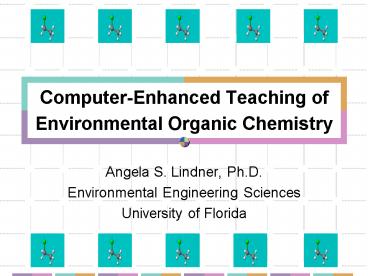ComputerEnhanced Teaching of Environmental Organic Chemistry
1 / 21
Title:
ComputerEnhanced Teaching of Environmental Organic Chemistry
Description:
Department of Environmental Engineering Sciences, UF. Mr. Randy Switt, Environmental Engineering Sciences, UF. Ms. Heidi Klein, CAChe Group, Fujitsu ... – PowerPoint PPT presentation
Number of Views:132
Avg rating:3.0/5.0
Title: ComputerEnhanced Teaching of Environmental Organic Chemistry
1
Computer-Enhanced Teaching of Environmental
Organic Chemistry
- Angela S. Lindner, Ph.D.
- Environmental Engineering Sciences
- University of Florida
2
Goals of This Presentation
- To introduce CAChe software and required hardware
- To present examples for enhancing the study of
environmental organic chemistry using computer
software - To provide initial outcomes of using
computer-aided chemistry as a teaching tool in
the environmental engineering classroom
3
Structure of This Presentation
- Introduction
- EES 4200, Chemistry of Carbon Compounds
- CAChe software
- Methods
- Overview of CAChe-enhanced concepts
- Examples of how CAChe can be used in lectures
- One-Year Assessment
- Conclusions to Date
- Future Plans for Use of CAChe Software
4
The Course Chemistry of Carbon Compounds
- Objective present fundamental organic chemistry
concepts with an environmental focus to the
sophomore-level environmental engineer and
environmental scientist - Class size 40-60
- Course details 2 required credit hours taken in
lieu of traditional organic chemistry
5
The Predicament
- Time
- Only 2 lecture hours per week
- Class size
- Large number makes use of models difficult
- Motivation level
- The majority of students must be convinced of
organic chemistrys role in the study of the
environment!
6
Solutions
- Employ a variety of teaching styles
- Coverage is the enemy!
- Use student portfolios
- Use CAChe 4.4 software
7
CAChe 4.4 Software
- CAChe Group, Fujitsu, Beaverton, OR
- WEB site
- www.CACheSoftware.com
- Selected features
- 3D visualization of molecules
- Prediction of properties (boiling points, vapor
pressure, water solubility, etc.) - Prediction of electron densities and locate
reactive sites - Identification of structure of low-energy
conformations - Prediction of activities (toxicity, reaction
rates, etc.)
8
Current CAChe Users in Higher Education
- Over 350 universities and colleges in North
America are listed as CAChe users. - Approximately 30 of these use CAChe in teaching
laboratory environments.
9
Laboratory Architecture and Cost
- Hardware needs
- IBM 486 or Compatible (Pentium recommended)
- Windows 95 or NT 4.0 Operating System
- 16 MB RAM (24 recommended) and 50 MB hard disk
space - Ethernet connection and Group Server for
Satellite software - Academic Cost
- CAChe WorkSystem 1995
- CAChe Satellite 900
- CAChe GroupServer(1-4 users) 4500
- (HEP grant provided a 33 discount.)
10
Introductory Concepts Lewis Structures, VSEPR
Theory, Molecular Shapes, etc.
Trichloroethylene
Ethanol
Trichloroethylene
Ethanol
MTBE
11
Skeletal Isomers C5H12
2-Methylbutane
2,2-Dimethylpropane (Neopentane)
n-Pentane
12
Positional Isomers C12H8Cl2
2,5-dichlorobiphenyl (para substitution)
2,3-dichlorobiphenyl (ortho substitution)
2,3-dichlorobiphenyl (ortho substitution)
2,4-dichlorobiphenyl (meta substitution)
13
Functional Group Isomers C5H12O
MTBE
Isopentanol
14
Computational Capabilities of CAChe
15
Bond Lengths (MOPAC with PM3 Parameters)
Ethane
Ethylene
Acetylene
CC 1.34 Angstroms
C-C 1.54 Angstroms
C C 1.21 Angstroms
16
Substituent Effects on Selected Properties (MOPAC)
Vinyl Chloride
Ethylene
VC ETH E- density (Cl or H) 6.97 0.92 Heat
of formation (kcal) 9.70 16.60 Ionization
potential 9.83 10.64 Dipole moment 0.90 0.00
17
CAChe in Environmental Chemistry
Structure
Forces
Dipole-Dipole Van der Waals Hydrogen Bonding
Properties
TB S Kow VP KH Koc
Mobility in aqueous phase Sorption
potential Bioaccumulation potential Escape to
vapor phase
Behavior
18
Which is more likely to migrate to a nearby
drinking water well?
Hexachlorobenzene
Pentachlorophenol
Dipole moment 0.429 1.105 Van der
Waals 8.943 10.505
19
Conclusions Benefits of CAChe Use in the
Engineering Classroom
- Better visualization of molecules
- Removal of some memorization work
- Reinforcement of traditional concepts of organic
chemistry - Introduction of the environment into organic
chemistry - Connection of structure to behavior in
environment - Reinforcement of environmental engineering as
multidisciplinary - Students prefer this approach to traditional
organic teaching methods!
20
Future CAChe Use at UF
- Laboratory format with problem modules
- Six laptops with CAChe satellite
- Calculations performed on a group server
- Better understanding of mechanisms
(dehalogenation, nucleophilic substitutions,
etc.) - Graduate-level course in bioremediation
- Integrate research into the curriculum
- Quantitative structure-activity relationships
- Visualization of reactions at enzyme active site
21
Acknowledgements
- National Science Foundation, SUCCEED Program, UF
- Department of Environmental Engineering Sciences,
UF - Mr. Randy Switt, Environmental Engineering
Sciences, UF - Ms. Heidi Klein, CAChe Group, Fujitsu































